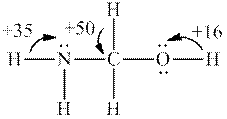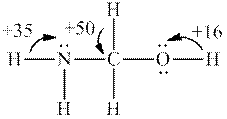
Concept explainers
a)
Interpretation: Each number and the most acidic hydrogen in below molecule should be determined.

Concept introduction: Electronegative elements have tendency to attract electrons towards it. Since electrons are shared more towards electronegative element, it acquires partial negative charge on it. As a result, other bonded atom develops partial positive charge. Polarization in any molecule arises due to electronegativity difference between bonded atoms. Polarization that is caused by electronegative atom can induce polarization in neighboring bonds to very small extent. This effect is known as inductive effect. Due to this effect, hydrogen attached to positive atom become more acidic than that on neutral atom. This also explains more acidic nature of hydrogens attached to electronegative atoms as compared to other atoms.
b)
Interpretation: Whether the most acidic hydrogen in below structure is consistent with fact that this molecule has

Concept introduction:
Want to see the full answer?
Check out a sample textbook solution
Chapter 4 Solutions
Organic Chemistry: A Guided Inquiry
- They are Sn1 and Sn2 reactions Answer step by step with explanation Please answer correct i will give you upvote.arrow_forwardFor the following pairs of alcohols, identify the one that is more acidic and explain your choice using ARIO. I said that the molecule on the left side was more acidic due to the e- withdrawing effect, however, my professor stated that resonance takes priority thus the molecule on the right side is the one that is more acidic. Can you explain to me why using ARIO? Thanks in advance!arrow_forwardThe drawing here on the right is the answer I submitted, but it says it is wrong and requires a carbocation.arrow_forward
 Organic Chemistry: A Guided InquiryChemistryISBN:9780618974122Author:Andrei StraumanisPublisher:Cengage Learning
Organic Chemistry: A Guided InquiryChemistryISBN:9780618974122Author:Andrei StraumanisPublisher:Cengage Learning
